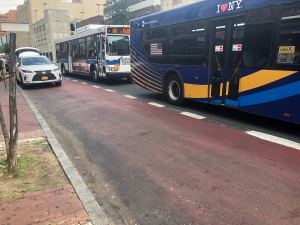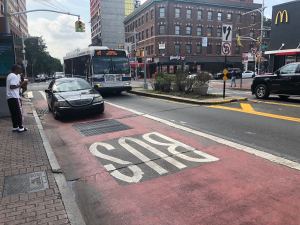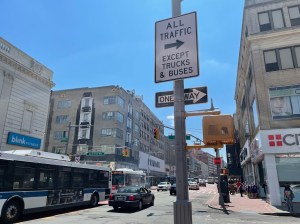Two New Busways Open in Jamaica, But Locals, Pols Still Wary for Some Reason

Roll out the red carpet!
City and state officials snipped the ribbon on a pair of long-delayed parallel busways in Downtown Jamaica on Friday — the most “impactful bus improvements” in the city’s history, according to Mayor de Blasio — but the area’s own council member and straphangers aren’t yet buying it.
Nonetheless, Council Member Daneek Miller, who along with other local pols had railed against both the car-free Jamaica and Archer avenue transit projects last month and demanded changes, stood awkwardly beside DOT Commissioner Hank Gutman to kick off a project that will help more than 250,000 bus riders daily even as he demanded more.
“In concept and theory, we absolutely support 300,000 residents that travel these corridors,” said Miller, a former bus driver, referring to himself and DOT. “We think investment in this community is great, and what we think is equally important is discourse. … We haven’t always been on the same page, I’m not sure we’re on the same page right now. But we absolutely have to figure out a way to move these people and ease congestion in a more efficient way. Are we there? I think we have some work to do. The commissioner and I have spoken about what needs to get done in the future, this is progress but we will continue to have a conversation.”
Gutman agreed that it will continue to be a work in progress.

“It’s going to be an ongoing dialogue,” he said.
What’s the big deal? Last summer, Miller asked DOT to put the city’s planned Jamaica Avenue busway on Archer Avenue instead —a request that delayed the project to benefit long-suffering transit riders. Eventually, the city ended up expanding its plan to two car-free busways: one on Archer Avenue between 150th and 160th Streets and the other on Jamaica Avenue between Sutphin Boulevard and 168th Street.
Prior to the busway on Jamaica Avenue, which serves 147,000 daily bus riders on 15 routes, there were two lanes in each direction — a westbound dedicated bus lane between Sutphin Boulevard and Parsons Avenue, and an eastbound dedicated bus lane runs between Parsons Avenue and 168th Street. Both operated only during the morning and evening rush hours. Now, the corridor is restricted only to buses and commercial trucks. Passenger vehicles will be able to access most blocks, but would have to exit via the first available right turn.
And on Archer Avenue — which is used by thousands more people who commute locally or via the adjacent Long Island Rail Road and E, J and Z subway lines — there were also previously two lanes in each direction, though one lane is already painted as a dedicated bus lane in each direction 24/7. And now in effect are double bus lanes eastbound between 150th and 160th streets. There is no curbside access, all eastbound traffic must turn left on 153rd Street, and DOT installed jersey barriers to prevent illegal vans from entering the busway, according to the agency.

Both busways will be in effect 24/7, according to DOT, but that could change, Gutman said.
At the kick off on Friday, riders were apprehensive that the new busway would actually do anything to speed up their commute times, fearful that illegal car traffic will undermine its intended goal, just as it does on nearby Merrick Boulevard, and on Jay Street in Brooklyn.
“[The busway] probably is a good idea, but I don’t think it’ll help,” said Jay, a Q5 rider. “It’s gonna take more than this to make it faster.”
And another Q5 bus rider, who also said she supports the busway while also being an occasional driver, was even less hopeful.
“I have very little faith in this system. They say they’re gonna do something and it never happens,” said Denise Plaines.



